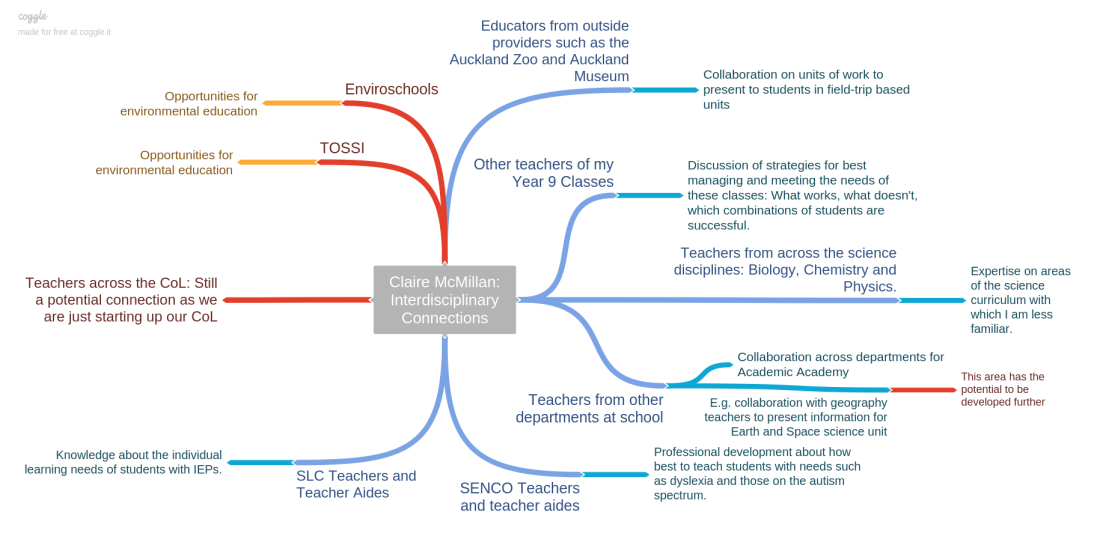My interdisciplinary connection map

Connections in blue are current interdisciplinary connections; red represents potential connections or potential development of current connections.
Developing potential connections: A near future goal
Mahurangi College has recently become a member of a CoL comprising the college and several primary schools in the Mahurangi area that feed into the college. This new community provides opportunities for developing connections between the primary and secondary sectors, as well as potentially increasing collaboration across departments at the college by creating a climate for discussion of learning goals for our students.
As a secondary school teacher in a Year 7-13 college, I have often felt that there is something of a disconnect between the way students learn during their primary years and what we expect at secondary school. The formation of the CoL will allow the group of schools to develop a clear vision for what we hope students will be able to gain from an education in our Community of Learning.
Mulligan and Kuban (2015) describe the importance of those participating in interdisciplinary practice in identifying common goals to make the focus of this practice. For example, a particular passion of mine is information literacy – I think it is of particular importance, particularly in these days of constant bombardment with information, that our students have the skills to identify the veracity of what they are reading or viewing. A goal of mine would be to work with teachers from other disciplines, both primary and secondary for how this could be made a focus throughout students’ educational lives. The American Association of Colleges of Nursing (2015, cited by the Mindlab, 2017) identifies the difference between multidisciplinary collaboration and interdisciplinary practice in that in that in a multidisciplinary plan, different disciplines are working in parallel towards the same goal, whereas, interdisciplinary involves the disciplines planning and making decisions together.
Interdisciplinary is preferable to multidisciplinary collaboration in scenarios such as the goal I have described above not only because it helps to spread the workload of planning for the teachers involved, but because it helps to ensure the common goal is clearly defined – we are all paddling our waka in the same direction, if you will.
Interdisciplinary collaboration by educators can be very beneficial for students, as a clear common goal held by these educators will help students, in the words of Jones (2009), to ‘synthesise information across different disciplines’ – that is, they will see how their learning is relevant across all aspects of their schooling and this should better allow them to see how what they learn in school is relevant to their lives.
Completing this entry on interdisciplinary practice has made me feel very positive about the potential impact my school’s joining of the CoL can have on my students.
References
Jones, C.(2009). Interdisciplinary approach – Advantages, disadvantages, and the future benefits of interdisciplinary studies. ESSAI7 (26), 76-81.
Mulligan, L. M., & Kuban, A. J. . (2015). A Conceptual Model for Interdisciplinary Collaboration. Retrieved from http://acrlog.org/2015/05/14/a-conceptual-model-for-interdisciplinary-collaboration
Kia ora Claire, thank you for sharing your post – I completely understand your comment about feeling the disconnect between Primary and Secondary learning. As an art teacher, students come to high school and are far below where they should be on the curriculum level. Have you considered how information literacy could be purposefully tied together between the Primary and Secondary schools in your CoL? What do you think the common goal could be? I look forward to hearing how this works for you all!
LikeLike
Kia ora Claire,
Thank you for sharing your post. My school is part of a a CoL. We are a full primary and have 2 secondary schools that our students feed into. I believe that some of the secondary teachers in our CoL felt the same way as you in terms of the expectations of skills and knowledge the students coming from primary school needed. I thought that we were doing a good job at preparing our students for secondary school. We now have more open lines of communication between the schools in the CoL and often do professional development together (AsTTle moderation in mixed primary and secondary groups), also sharing information and concerns. We are certainly have our students at the forefront and think this is a good step forward.
LikeLike
Hi Katie, thanks for your feedback. I didn’t mean at all in my post to imply that primary teachers aren’t doing a good job, so I hope you didn’t feel that way. What I do think though is that sometimes we are working at cross purposes, with different ways of doing things that can make the transition between primary and secondary more confusing than it needs to be for students! So as you say, open lines of communication between primary and secondary educators in a CoL will be very helpful. I do think that secondary can learn a lot from primary education in terms of becoming more flexible in the way we teach our students. In return, specialist-subject secondary teachers can provide content updates for primary teachers teaching content outside their own area of expertise.
LikeLike